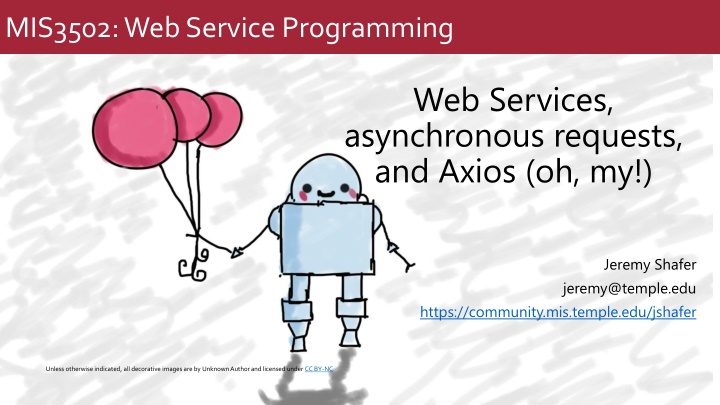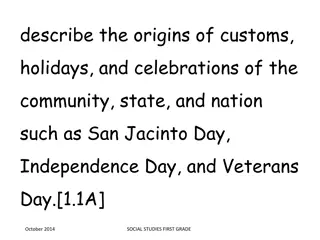
Asynchronous JavaScript and Axios in Web Service Programming
Explore the concepts of asynchronous versus synchronous code, utilizing Axios for resource leveraging, and the significance of non-blocking JavaScript in web development. Dive into practical examples and insights to enhance your understanding.
Download Presentation

Please find below an Image/Link to download the presentation.
The content on the website is provided AS IS for your information and personal use only. It may not be sold, licensed, or shared on other websites without obtaining consent from the author. If you encounter any issues during the download, it is possible that the publisher has removed the file from their server.
You are allowed to download the files provided on this website for personal or commercial use, subject to the condition that they are used lawfully. All files are the property of their respective owners.
The content on the website is provided AS IS for your information and personal use only. It may not be sold, licensed, or shared on other websites without obtaining consent from the author.
E N D
Presentation Transcript
MIS3502: Web Service Programming Web Services, asynchronous requests, and Axios (oh, my!) Jeremy Shafer jeremy@temple.edu https://community.mis.temple.edu/jshafer Unless otherwise indicated, all decorative images are by Unknown Author and licensed under CC BY-NC
Start up Start up VS Code Get ready! Sign in Sign into AWS Console Download demo_stooges.zip and unzip it to be worked on locally Download 2
Agenda 1. Understanding asynchronous vs. synchronous code 2. Using Axios to leverage resources 3
Lets start with some fun These are the three stooges: Larry, Moe, and Curly. 4
This is a script 5
Ok good to know how is this relevant? These ideas can help us think about: Why do all that nasty thinking? 1. What does it mean for communication to be asynchronous? 2. Why JavaScript is called a "non- blocking" language? 3. An experiment with an API that doesn't always respond in a timely fashion. 1. Understand JavaScript a bit better 2. Understand Web Development a bit better 3. Prepare you to work with multiple APIs (like, in the class project) 6
What does it mean for communication to be asynchronous? VS Talk, wait, talk... Super polite. (Synchronous) Everyone talks at once. No one waits for anyone. (Asynchronous) 7
Non-blocking That's why we need callback functions! Why is JavaScript called a "non-blocking" language? VS When we call a resource that is outside the script, the script will not wait. The script will not be "blocked". 8
Why this matters Often, this behavior is exactly what we want. The www is full of resources, and it is not realistic to think that everything will run like clockwork! But .. Sometimes we need to put multiple asynchronous tasks in sequence. Slide 9
So what can we do? With today's demo file, I will illustrate three different approaches to getting multiple, asynchronous calls, to work in a desired sequence. Basically, we'll be forcing JavaScript to do something that is contrary to its nature! By nature, JavaScript is non-blocking when it processes calls to external resources. But sometimes I want that blocking behavior. Sometimes I want to wait. How can I get blocking behavior when I want it? The three different approaches are: 1. Chain the functions together using their callback functions. (Perhaps the easiest.) Remember, there's more than one way to skin an alligator! 2. Store intermediate results in the DOM. Trigger on DOM changes. (A bit harder, but more flexible.) 3. Use async / await from ES 2017. (The most modern approach.) 10
What we have seen so far (Database) (Your Lambda code) (Client-side code) (We used jQuery to make Ajax requests) (Third-party API) 11
The final frontier jQuery does not run here! (Database) (Your Lambda code) (We can use Axios to make Ajax requests) (Third-party API) (Client-side code) (We used jQuery to make Ajax requests) Sometimes we do this to manage credentials. (Because I don t want my API key on the client.) Sometimes I do this to comply with CORS restrictions (Third-party API) 12
What is CORS again? CORS is short for Cross Origin Resource Sharing. CORS is an industry accepted convention for communicating how the owners of a Web Service API want it to be used. If you are using a third-party API, you can t change the CORS policy of the API. You are not the owner! You must figure out a way to comply with the policy. Most CORS errors students encounter are the result of typos and/or AWS configuration mistakes. But sometimes you have a legitimate CORS restriction. Axios on the server-side can help you do that. 13
Examples of Axios code axios.get(url).then((response)=>{}); OR let response = await axios.get(url); These are just examples there is a lot more detail here: https://axios-http.com/ There s also: axios.post() axios.put() axios.patch() axios.delete() But wait, this is different from $.ajax I don t like it. FYI I don t think memorizing the axios syntax is important for you. Yep. But when you use new npm package, you don t get to choose syntax that is comfortable . But it is important that you when to use axios, and that you be able to read and apply the documentation. Can you believe it? The variable response will be a JSON object. Typically, you want the data attribute of that object. As in: response["data"] 14
Lets do an experiment with https://forismatic.com/en/api/ Sample: http://api.forismatic.com/api/1.0/json?method=getQuote&lang=en&format=text 15
Summary Here are some things students should be able to answer with confidence. 1. What does it mean that JavaScript is a "non-blocking" language? 2. Identify situations where JavaScript code will behave synchronously, and when it will behave asynchronously. 3. Describe three different approaches to force asynchronous responses to be executed in sequence. 1. Callback functions used in succession 2. Listening for a change event on an HTML tag (and how we did it!) 3. The async/await mechanism from ES 2017 (and how we did it!) 4. Verbalize why asynchronous code is inherently faster that synchronous code. 5. Explain what Axios is, and why it is needed. 16






















